FAQ
Answers to the most common questions about the TR Site.
“It takes less in the way of ceremony to make a President in this country, than it does to make a King in England or any monarchy, but the significance of the event is no less great.”
– Ansley Wilcox, 1902
(reflecting on the significance of TR’s inauguration)
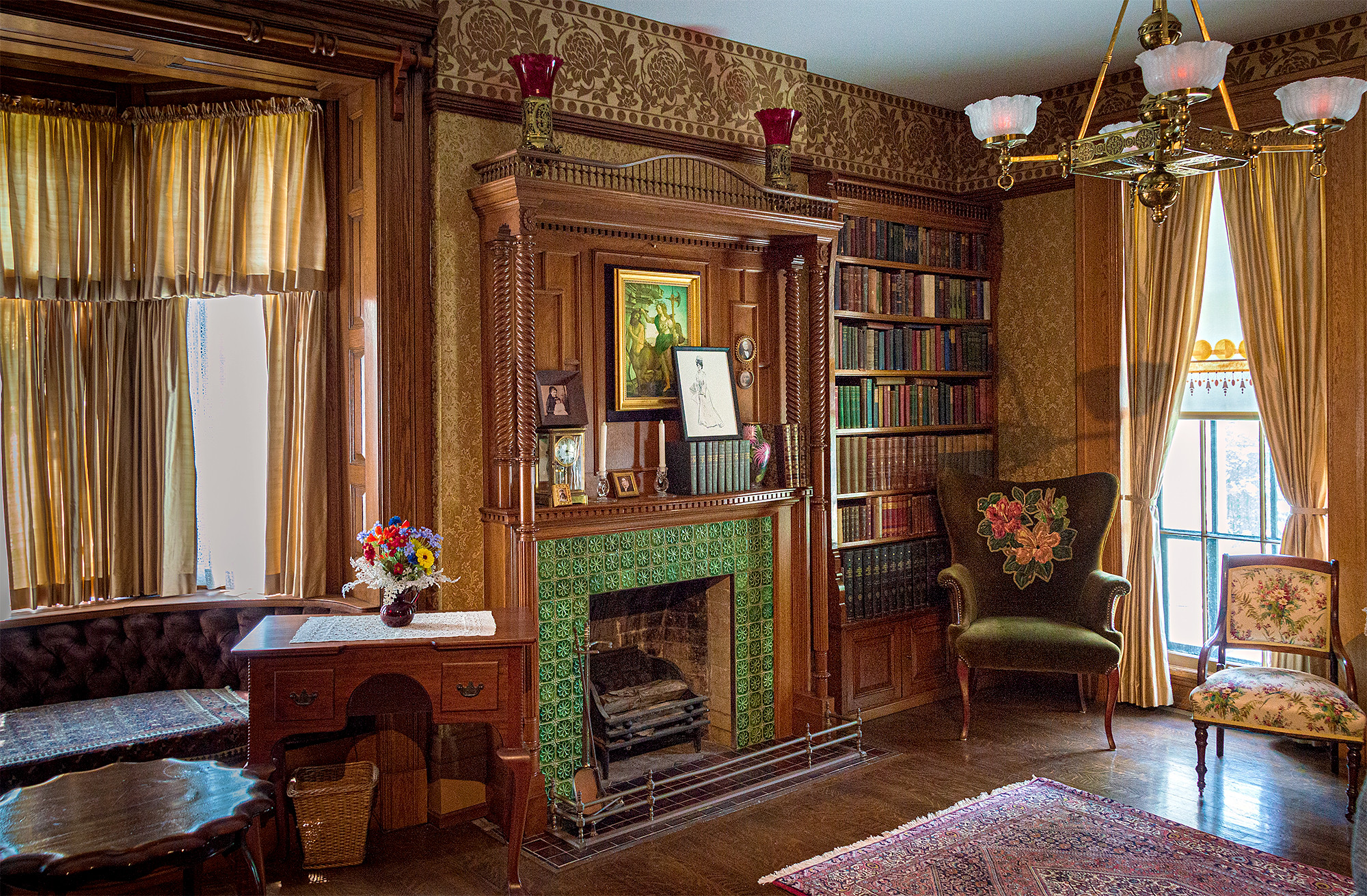
This reenactment was produced and filmed in 2001, to commemorate the 100th anniversary of Theodore Roosevelt’s 1901 inauguration.
September 5-6th, 1901

TR Site Collection (1991.004.002)
On March 4th, 1901, President William McKinley was sworn in for a second term, joined by a new vice president, Theodore Roosevelt. Six months later, McKinley visited Buffalo’s Pan-American Exposition with his wife, Ida. They arrived on Thursday, September 5th (“President’s Day”) and the extremely popular president spoke before the largest crowd assembled at the Exposition.
Following a visit to Niagara Falls the next morning, the president’s entourage returned to Buffalo for a public reception in the Exposition’s Temple of Music. McKinley enjoyed shaking hands and meeting the public, although his personal aides expressed concerns about this type of event. There had been a number of recent political assassinations in Europe and the anarchist movement had spread across the Atlantic. With some safety measures in place, McKinley insisted on meeting his constituents.
Shortly after 4 o’clock, a 28-year-old man named Leon Czolgosz approached McKinley in the receiving line. Since Czolgolsz’s right hand was bandaged, the president offered his left hand in greeting. Czolgosz suddenly fired two shots from a gun that was concealed by the bandages. Czolgosz was about to fire a third shot when he was knocked to the ground by James Parker, an African-American waiter at the Exposition, and several others. The president reportedly reacted by saying, “Let no one hurt him.” Czolgosz was taken into custody and removed to police headquarters.
President McKinley was taken by electric ambulance to the small Exposition hospital for evaluation. Established to treat minor ailments, the hospital was not equipped for major surgery but the assembled doctors agreed that time was of the essence and it was too risky to move the president. It was decided that the surgery should take place at the Exposition hospital.
Under the circumstances, the operation went smoothly and McKinley remained in good condition. Nonetheless, doctors were unable to locate and remove one of the bullets. Believing it had ended up in fatty tissue and would not pose any further threat, doctors closed the wound.
According to the practice of the day, the president was moved to a private home to recover. Since the McKinleys had been staying with Pan-Am Exposition president John Milburn, President McKinley was brought back to his home at the corner of Delaware Avenue and West Ferry Street.
September 7-10th, 1901

“Vice-President Roosevelt Being Interviewed by…the Press at the Milburn Residence, Buffalo.” – Photograph by R. L. Dunn
Vice President Theodore Roosevelt, in Vermont for a speaking engagement, was quickly notified about the assassination attempt. He arrived in Buffalo the following day and accepted an invitation to stay with his friend, attorney Ansley Wilcox. A temporary office for the vice president, including a telegraph, was set up in Wilcox’s Delaware Avenue home, about a mile south of the Milburn house.
Most members of McKinley’s cabinet came to Buffalo as well. They set up residence at the Buffalo Club, which was not quite a mile further south on Delaware Avenue.
For several days following the surgery, McKinley’s condition improved and it was believed the president would make a full recovery. Assured that McKinley was out of danger and to demonstrate his confidence in the president’s continued progress, Roosevelt left Buffalo late in the evening of Tuesday, September 10th. He joined his wife and children, who were vacationing in the Adirondack Mountains of northern New York State.
TR left his itinerary and contact information with Ansley Wilcox, just in case it was needed.
September 12-14th, 1901

Mt. Marcy, Adirondack Mountains, New York State
Wilcox later recalled being woken up by a messenger “[i]n the middle of the night between Thursday [Sept 12] and Friday [Sept 13]…asking me to send instantly for the Vice-president, as the President had suddenly become worse and was in great danger. Then began a vigorous effort to annihilate time and space…”
Roosevelt was returning from a hike up Mt. Marcy (New York’s highest peak) when he was met by an Adirondack guide who delivered an urgent message bearing the news of McKinley’s worsening condition. TR was advised to return to Buffalo immediately, but first he had to finish his descent on foot.
It was dark by the time Roosevelt reached the horse-drawn wagon that was waiting to rush him to the nearest train station, thirty-five miles away. After a treacherous ride, TR arrived at the North Creek train station just before dawn on Saturday, September 14th, 1901.
At North Creek, Roosevelt learned that William McKinley had died several hours earlier, at 2:15 am. Without delay, the new president boarded a train for Albany and, from there, another train bound for Buffalo.
Ansley Wilcox was waiting for Roosevelt at the train station in Buffalo when he arrived at 1:30 pm, and later recalled, “[T]here was great excitement in the city, and all precautions were taken for his safety…[he] was driven rapidly up to my house again, followed by a small escort of cavalry, which had been stationed off at some distance in order not to attract a crowd.”
The most pressing issue upon Roosevelt’s arrival was where and when he should take the oath of office. According to Ansley Wilcox:
No definite plans had been made for swearing him in and it had not even been settled where this should be done. The first suggestion had been to take him directly to Mr. Milburn’s house, there to be sworn-in, but this had been objected to as unsuitable, while the body of the president was lying in the house. So he was asked to go to my house to get lunch, and immediately at arriving and being equipped with borrowed clothes, more appropriate than his traveling suit, he insisted on starting for Mr. Milburn’s house, to make a call of sympathy and respect on the family of the dead president. This was done, and by three o’clock he was at my house again.
Afternoon of September 14th, 1901
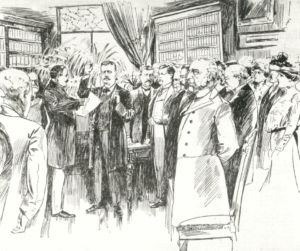
“President Roosevelt Taking the Oath of Office in the Library of the Wilcox Residence, Buffalo…”
Printed in the Nashville (TN) News | Oct, 1901 [?]
The cabinet began arriving at the Wilcox home as soon as Roosevelt returned. Six of the eight cabinet members were present: Secretary of War Elihu Root, Secretary of the Navy John Long, Attorney General Philander Knox, Secretary of the Interior Ethan Hitchcock, Secretary of Agriculture James Wilson, and Postmaster General Charles Emory Smith. Absent were: Secretary of State John Hay and Secretary of the Treasury Lyman Gage.
United States District Judge John R. Hazel was asked to administer the oath. Wilcox remembered, “The room [the library], not a large one, was far from full, and at the last moment, the newspaper men, who were eager for admission, were all let in, but were prohibited from taking any photographs.”
For a few moments, no one seemed certain what to do. The Buffalo Courier of September 15th, 1901 recorded in detail what happened next:
There was a moment of extreme quietness. It was now 3:31 o’clock. Secretary Root, advancing a step forward, began to speak. His voice was low and not clearly audible. Evidently his emotions were deeply touched. Tears were in his eyes. “Mr. Vice-President, I […]” commenced Secretary Root, but his voice broke and for fully a minute he could not utter another word. His Cabinet confreres were all affected. Tears came into their eyes. It was a touching scene at this moment and about every head was bowed as there welled up in the hearts of these devoted men the memory of the beloved man whose life had been offered as a sacrifice on the alter of his country. Tears trickled down the cheeks of Secretary Root. The Vice-President’s eyes were moist and he clutched nervously at the lapel of his frock coat….
Taking a step toward Secretary Root the Vice-President said, in a voice that wavered at first, but grew stronger with each succeeding word: “I will take the oath at once in accord with the request of you members of the Cabinet, and in this hour of our deep and terrible bereavement I wish to state that it shall be my aim to continue absolutely unbroken the policy of President McKinley for the peace, the prosperity and the honor of our beloved country.” …Judge John Hazel read the oath and Col. Roosevelt repeated it after him: ” I do solemnly swear that I will faithfully execute the office of President of the United States, and will, to the best of my ability, preserve, protect and defend the Constitution of the United States….And thus I swear.”
At the age of 42, Theodore Roosevelt had been inaugurated as the 26th President of the United States and the youngest man to be sworn in to that office.
Ansley Wilcox later described the historic event that occurred in the library of his home:
…the new President was standing in front of the bay window on the south side of the room. Others had fallen back a bit when Mr. Root spoke. After his response, Judge Hazel advanced and administered the oath…The written oath, which Judge Hazel produced…was then signed. Then President Roosevelt made the announcement of his request to the cabinet to remain in office. The whole ceremony was over within half an hour after the Cabinet had entered the house, and the small company dispersed, leaving only the six Cabinet officers with the President, who at once held an informal session in the library.
Afternoon of September 14th, 1901
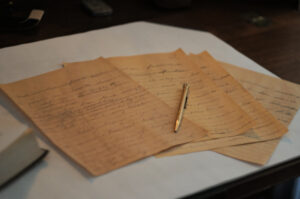
A traditional inaugural address would have been inappropriate, given the tragic and unusual circumstances surrounding TR’s swearing in. Instead, following the ceremony, he drafted his first Presidential Proclamation in the morning room of the Wilcox house. The final version read:
A terrible bereavement has befallen our people. The President of the United States has been struck down–a crime committed not only against the chief magistrate, but against every law-abiding and liberty-loving citizen.
President McKinley crowned a life of largest love for his fellow men, of most earnest endeavor for their welfare, by a death of Christian fortitude; and both the way in which he lived his life and the way in which in the supreme hour of trial he met his death WILL REMAIN FOREVER A PRECIOUS HERITAGE of our people.
It is meet that we as a nation express our abiding love and reverence for his life, our deep sorrow over his untimely death.
Now, therefore, I, Theodore Roosevelt, President of the United States, do appoint Thursday next, September 19, the day in which the body of the dead President will be laid in its last earthly resting place, as a day of mourning and prayer throughout the United States. I earnestly recommend all people to assemble on that day in their respective places of divine worship there to bow down in submission to the will of Almighty God, and to pay out of full hearts their homage of love and reverence to the great and good President whose death has smitten the nation with bitter grief.
In witness whereof I have hereunto set my hand and caused the seal of the United States to be affixed.
September 15-16th, 1901
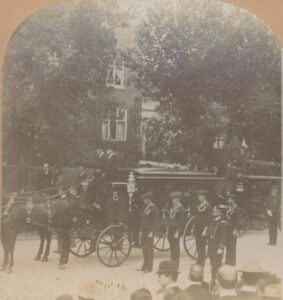
The day after TR’s unusual inauguration was Sunday, September 15th. That morning, the new president had breakfast with the Wilcoxes and the Rev. Dr. S.S. Mitchell, pastor of Buffalo’s First Presbyterian Church. Shortly before 11 o’clock, Ansley and Mary Grace Wilcox traveled with President Roosevelt to the Milburn House, where they attended funeral services for the late president.
Upon their return to the Wilcox home, TR spent a “very quiet Sunday” that included lunch and dinner meetings with various cabinet members and elected officials. Meanwhile, the new president’s staff was kept busy reading and categorizing more than 600 telegrams and letters.
At 7:30 the next morning (Monday, September 16th), Roosevelt and an advisor ate breakfast with Ansley Wilcox. A short time later, the new president boarded the funeral train that had already been loaded with McKinley’s casket, and began the long journey back to Washington, DC.
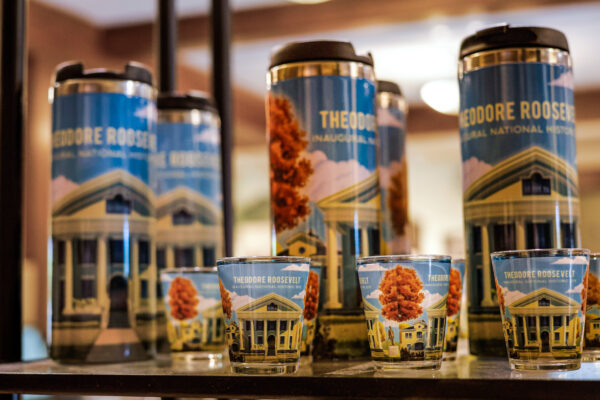
Answers to the most common questions about the TR Site.
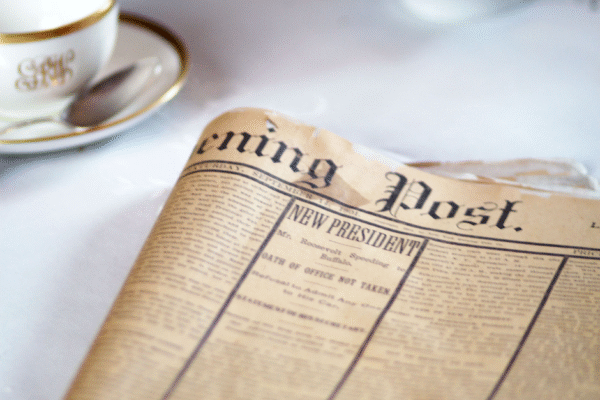
Tours are just the beginning! Check out our special programs...
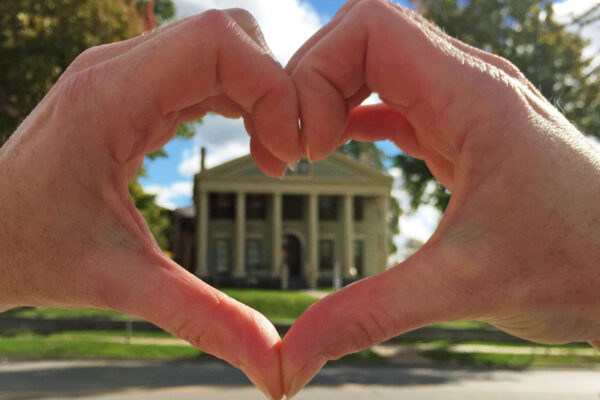
The "In-SITE" blog provides an insider's view of the TR...
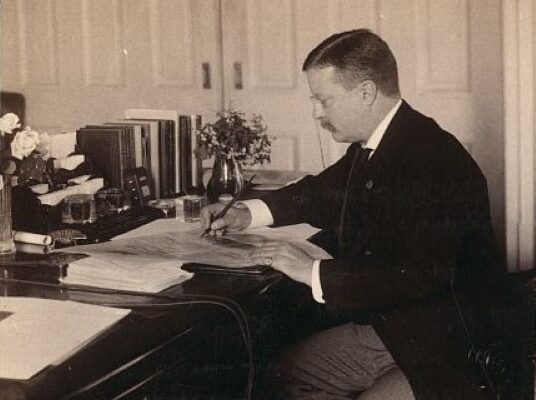
Get in touch! We'll answer your questions.